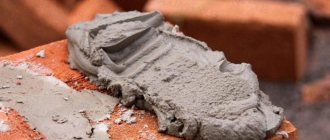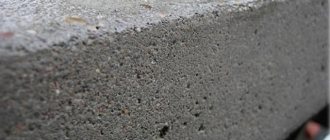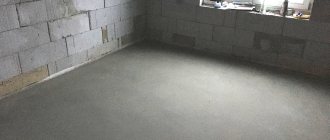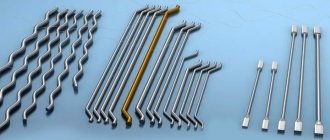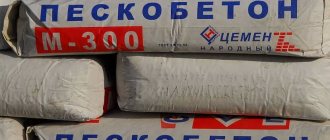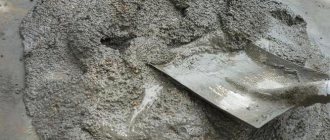During the construction process, various types of concrete are used, which differ in strength, specific gravity and other characteristics.
Among the building materials popular nowadays, it is worth highlighting sand concrete.
Mixtures of this type are easy to both produce and use, and in both cases they are economically beneficial.
According to the classification of the state standard GOST 7473-94 “Concrete mixtures. Technical conditions", sand concrete belongs to fine-grained concrete mixtures (FCM), and according to its intended purpose - to structural concrete and has the characteristics indicated in the tabular data.
In accordance with GOST 7473-94 “Concrete mixtures. Technical specifications”, according to the degree of preparation of the mixture, are divided into the following types:
- ready-to-eat (RBG);
- dry mixes (DSM).
Based on workability, mixtures are divided into groups:
- super-hard (SZh);
- hard (F);
- movable (P).
Concrete mixtures are classified as follows:
- concrete mixtures of lightweight concrete (LBC),
- concrete mixtures of fine-grained concrete (BSM),
- concrete mixtures of heavy concrete (BCT).
Important!
The marking of a concrete mixture consists of an abbreviated designation of the mixture by readiness, type and class of concrete by strength, grade by workability, frost resistance, water resistance, medium density (for lightweight concrete) and the designation of the standard.
For example, BSG V25 P1 F200 W4 GOST 7473-94 is deciphered as follows:
- BGS – ready-mixed concrete mixture of heavy concrete;
- B25 – compressive strength class (in MPa);
- P1 – grade for workability;
- F200 – frost resistance grade;
- W4 – waterproof grade.
What is sand concrete?
Strictly speaking, “sand concrete” is the common name for concrete mixtures of fine-grained concrete (FMC), the main components of which are Portland cement and mixed sand (fraction up to 4 mm), as well as plasticizers and other additives.
Interesting!
Luxury sand concrete has increased strength, mobility and accelerated strength development.
CHARACTERISTICS OF SAND CONCRETE
Sand concrete has the following technical characteristics: gray color, 180 minutes - setting time, frost resistance index - 50, 0.15-0.18 liters of water are required per 1 kg of dry mixture.
This material has quite a lot of advantages. He:
- resistant to corrosion and temperature changes;
- easy to prepare and install;
- has a long service life;
- has high heat and sound insulation characteristics
- inexpensive.
The characteristics of sand concrete M 300 make it possible to distinguish it from other brands.
SAND CONCRETE CONSUMPTION PER 1 M2.
For many people planning renovations, it is very important to know the consumption of building materials. If we are talking about replacing the floor, first of all you need to calculate the consumption of sand concrete for the floor per square meter of screed.
If the surface does not have significant flaws, then the cost of materials on average can be 19-20 kg of sand concrete per 1 m2 with a layer thickness of 1 cm. Sand concrete consumption is calculated for grade M 300.
If the floors are leveled, the consumption of sand concrete may vary; in this case it is difficult to accurately calculate.
When installing heated floors with a layer thickness of 4-5 cm, the amount of mixture is about 72-80 kg per 1 m2. The thickness of the layer in this case depends on the type of floor: infrared, electric or water.
Sand concrete brands
It is customary to separate the following grades of sand concrete: M 100, M 150, M 200 and M 300. Using these mixtures, ceilings, walls and floors are leveled. M 300 can withstand a load of 300 kg per cm2. Other brands have lower strength, but can be used in normal household conditions. M 300 is considered the ideal brand of sand concrete for floor screed, as it is strong and durable.
Storage of sand concrete is allowed for a period of no more than 6 months at low humidity. Transportation of sand concrete
APPLICATION OF SAND CONCRETE IN CONSTRUCTION
Sand concrete is used for:
- brickwork;
- foundation arrangement;
- sealing joints and seams;
- for screeds and floors;
- production of monolithic slabs and sand concrete blocks;
- embedding of reinforced concrete structures.
High-quality sand concrete is produced at special enterprises with appropriate equipment. First of all, the recipe is approved taking into account the proportions. Next, all the constituent substances are sent to a concrete mixing plant and mixed. The finished mixture is packaged in paper bags.
Material Information
Description and benefits
Sand concrete is a construction mixture that includes components such as Portland cement (from M300 to M500), sand and chemical additives that improve the performance of the material.
Photo of bulk material
According to the GOST classification, depending on the grade, sand concrete is classified as fine-grained or coarse-grained concrete.
This material has a number of advantages in use:
- Precisely measured and indicated proportions of ingredients.
- Easy to prepare and lay the mortar, allowing you to save on the involvement of master concrete workers when screeding yourself.
- Excellent sound and heat insulation characteristics after hardening.
- Long service life.
- Corrosion resistance.
- Frost resistance, resistance to heat and temperature changes.
Surface of frozen material
Composition analysis
From different manufacturers, the composition of sand concrete, even of the same brand, may differ due to the use of different additives.
However, the main components can be identified:
- Portland cement.
- Washed sand, river sand, as well as coarse sand (up to 3 mm).
- Granite chips or screenings.
The proportions of the components are approximately 1 part cement to 4 parts of all sand fractions (and granite chips, if indicated in the composition).
Additives to improve properties
Additives play a special role in imparting performance properties to the material:
- Plasticizers.
- Hardening accelerators or retarders.
- Antifreeze additives.
Production Features
The main document regulating the grade indicators of sand concrete is GOST 7473-94. Today, brands from M-150 to M-500 are available on the market. The marking shows the size of the sand fraction, as well as the rate at which the mixture gains critical strength.
In answer to the question “Which sand concrete is better for floor screed?” experts agree: for most residential premises, the M-300 brand is optimal. Thanks to coarse sand, the surface is quite durable, while the cost of the material is quite affordable.
Most common brand
The quality of the sand concrete mixture is controlled by the manufacturer and depends on many factors.
Among them:
- The quality of the components.
- Quality of cleaning and drying of components.
- Features of the fractionation procedure.
- Compliance with the sequence of mixing the components.
Based on the analysis of the composition, we can conclude that you can make sand concrete yourself. Naturally, its price will be significantly lower, but the quality will also drop, since we will not be able to provide the entire technological process for producing the mixture ourselves.
And it is almost impossible to control the quality of cement and sand, the purity of water and the uniformity of mixing without proper preparation and equipment.
The conclusion is simple: if you don’t want to pay twice, buy industrially produced material.
Choosing a brand of sand concrete for floor screed
Depending on the composition of the mixture, sand concrete is produced in different grades (that is, different strengths). The minimum strength is M100, the maximum is M500. What type of sand concrete is needed for floor screed depends on how the floor will be used.
- M100 and M150 for screeds in most cases have insufficient strength; they are used more often for plastering walls. This mixture can be used to make flooring in utility rooms or in the country house. Its strength is more than enough to move people and animals, but not for transport. In a house, such a screed can be done if linoleum or carpet is simply laid and there is no heating.
- According to the recommendations of manufacturers, for laminate, vinyl tiles (art vinyl), parquet, parquet boards, ceramic tiles, porcelain stoneware, the base should have a strength of M200 or M250. Therefore, under these types of coatings, a screed of sand concrete of the appropriate brand is made.
The grade of sand concrete for floor screed is determined by the type of floor covering and how the floor will be used - Pouring screed over a heated floor (water or electric) is recommended by a brand no lower than M250. M300 is also possible. For normal heat transfer there must be sufficient density, which is what characterizes concrete of higher grades. The second point is that there must be a sufficiently strong ceiling over the flexible water heating pipes to prevent sagging and sagging under load.
- M300 - this strength can be used if a high load is provided. For example, when laying blocks or panels of multi-story construction, when pouring the foundation of a private house. For a non-heated floor in a private home, such strength is excessive. Perhaps for a garage where heavy vehicles will move. Less durable concrete can also withstand passenger cars. Sand concrete M300 can also be used for external work - for formwork around the house, for example. It is also suitable for pouring a platform for a car and for constructing concrete paths. It is usually frost-resistant enough to last for a sufficient number of years.
High-quality mixtures are used to fill the foundations of multi-story buildings. In private construction, it is not advisable to use a grade higher than M300 - There is simply no place to use concrete higher than M300 in private construction. This level of strength will not be in demand. And since the price increases with the increase in brand, there is no need to spend extra money.
In general, parquet used to be laid on a screed with a strength of M75 or even M50. Why are the requirements higher today? Because previously they used bitumen mastic. Its strength is close to these types of concrete. Modern glue, on which parquet or parquet boards are glued, has much higher strength. In order for the coating to stick and not move away from the base, the strength of the adhesive and the base should not differ by more than 50 units. Since the glue generally has a strength of M200 or M250, the base is required to be the same. Therefore, under the parquet we use sand concrete for floor screed M200 or M250.
The same applies to the floor on which ceramic tiles or porcelain stoneware are laid. Tile adhesive also has high strength. Therefore, the screed under the tiles should be made of sand concrete of a fairly high grade - M200 and no lower.
What is it for, scope of application
The usual area of application for sand concrete is thin screeds. The fact is that the minimum layer thickness for concrete is defined as twice the size of the largest aggregate. That is, for ordinary concrete with small crushed stone, no more than 25 mm in size, the minimum layer thickness is 50 mm. This thickness is not always needed and not everywhere. If there is a need for a thinner layer, it is advisable to use sand concrete.
The minimum thickness of sand concrete screed is 4 mm, the maximum is 100 mm. But the exact pouring thickness of each specific mixture is indicated on the packaging. When purchasing, pay attention to this. It is not worth making a layer less or more than recommended, as it may simply peel off and crumble.
If you compare the characteristics of different brands, the difference will be significant
Sand concrete can be used both indoors and outdoors. In order for it to serve for a long time outdoors, pay attention to such an indicator as frost resistance. This line contains the Latin letter F and numbers. The numbers show how many freezing/thawing cycles concrete can take out of a given mixture without loss of properties. For outdoor use, it is better if this indicator is 25 or higher. Anything less is for interior work.
Choosing a sand concrete manufacturer for floor screed
Having decided on all the parameters, you need to make the last, and perhaps the most difficult, choice. You need to decide which company to buy sand concrete from. There may be a dozen or more manufacturers in large specialized stores. It's easy to get confused.
There's really not much difference. It is important not to fall for a fake that was mixed up in the garage. This usually affects brands with a well-advertised name. If you know what the original packaging should look like, or the seller is trusted, you can use well-known brands. But regional factories are safer in terms of counterfeiting. Their quality is no worse, and there are very few fakes.
How to choose a manufacturer... Based on reviews and experience in using other mixtures
Another selection criterion is “heredity.” If you plan to pour a leveling screed over a regular screed, it is better if they are from the same manufacturer. In this case, there will be no questions about product compatibility. Then it’s better to buy everything at once - both leveling mixtures and sand concrete for floor screed.
Ratio of concrete mixture components for floor screed
The construction mixture for forming a monolithic floor includes three main components: lime cement, coarse river or quarry purified sand, and clean water. To increase the workability of the mixture, various synthetic additives can be added to the solution, for example, to increase viscosity or plasticity, but a properly mixed solution and a consistent ratio of bulk and liquid materials give excellent results, and the solution perfectly levels and adheres to the prepared floor surface without purchasing additives that will cost a pretty penny.
Building materials markets sell ready-packaged dry concrete mixture for floor screed. Their advantage is that it is possible to more accurately dose the proportions of concrete for floor screed and pour the working surface faster. There is only one drawback of such dry mixtures: they cost 1.5-2 times more than a mixture prepared independently. Therefore, in order to save money (and in individual construction this goal is constantly pursued), when given the task of pouring a floor on the ground at a minimum cost of building materials, the solution is prepared with one’s own resources and resources. In this case, it is necessary to observe the following proportions of concrete for pouring the floor inside a residential or non-residential building (in weight or volumetric proportions):
- One part of cement TsEM I 32.5H PC (M 400) to three and a half parts of river or washed quarry sand, and 6/10 parts of industrial water;
- One part of Portland cement CEM I 42.5H PC (M 500) to four parts of river or quarry sand, and 7/10 parts of industrial water.
The ratio of grades M 400 and M 500 to other components of the composition When mixing concrete, the developer has to independently measure the volumes (weight) of bulk or liquid substances and mix them, so the result (ready-made solution) will be much cheaper than a factory-packaged mixture. For M 400 and M 500, the ratio of components given in the list above will correspond to the concrete grade M 150. A similar grade of concrete is used for the floor in a garage or in other unheated rooms with high humidity.
The solution that will be poured and used outdoors differs in composition and proportions from the solution for indoor use. Screed in open space is constantly exposed to changes in temperature, humidity, weathering, and solar radiation, so its mechanical properties should a priori be better.
High-strength concrete screed for self-leveling floors
| Portland cement, brand | Concrete mortar, brand | Portland cement|sand|crushed stone (weight, kg) | Portland cement|sand|crushed stone (volume, l) | Volume of solution from 10 liters of Portland cement |
| 400 | 100 | 1,0|4,0;6,0|7,0 | 10|41|61 | 78,0 |
| 500 | 1,0|5,0;8,0|8,1 | 10|53|71 | 90,0 | |
| 400 | 150 | 1,0|3,0;5,0|5,7 | 10|32|50 | 64,0 |
| 500 | 1,0|4,0;5,0|6,6 | 10|40|58 | 73,0 | |
| 400 | 200 | 1,0|2,0;8,0|4,8 | 10|25|42 | 54,0 |
| 500 | 1,0|3,0;5,0|5,6 | 10|32|49 | 62,0 | |
| 400 | 250 | 1,0|2,0;1,0|3,9 | 10|19|34 | 43,0 |
| 500 | 1,0|2,0;6,0|4,5 | 10|24|39 | 50,0 | |
| 400 | 300 | 1,0|1,0;9,0|3,7 | 10|17|32 | 41,0 |
| 500 | 1,0|2,0;4,0|4,3 | 10|22|37 | 47,0 | |
| 400 | 400 | 1,0|1,0;2,0|2,7 | 10|11|24 | 31,0 |
| 500 | 1,0|1,0;6,0|3,2 | 10|14|28 | 36,0 |
An example of a concrete structure that will be constantly exposed to all kinds of atmospheric influences on the street is a concrete blind area around the circumference of a house or garage. In this case, the grade of concrete for the garage foundation should be M 150 and consist of the proportions of the components given below.
Blind area around the house
The surface of the finished screed must be ironed with pure cement:
- One part of Portland cement brand CEM I 32.5H PC (M 400) to four parts of river or purified quarry sand, five and a half parts of crushed stone (marble, gravel or granite chips) and 9/10 parts of clean industrial water;
- One part of Portland cement CEM I 42.5H PC (M 500) to 4.1 parts of river or purified quarry sand, five and a half parts of crushed stone (marble, gravel or granite chips) and 7/10 parts of clean industrial water.
For screeds or floors on the ground that do not experience large mechanical and shock loads, marble, gravel or granite chips acting as crushed stone can be replaced with construction rubble: brick waste, furnace or blast furnace slag, waste ceramic building blocks, etc.
Why is only the M 150 brand recommended? It complies with SNiP 2.03.13-88, which states that for pouring concrete screeds, building materials with a compressive strength of ≥ 15 MPa or 150 kgf/cm2 should be used, and these indicators are only suitable for grade M 150.
Recommendations for designing floors SNiP 2.03.13-88
Composition of sand concrete
The exact dosage of all ingredients is selected experimentally and depends on the quality of raw materials and sand concrete production technology (equipment for preparation, pumping and laying). Each one is rarely shared: it is considered a commercial success and is kept secret.
Important!
Concrete compositions are selected in enterprise laboratories in accordance with GOST 27006-86 “Concrete. Rules for selecting the composition” take into account the characteristics of the starting materials and the required qualities of concrete. Formulations should be tested and adjusted if necessary.
Portland cement based on clinker and gypsum, limestone and sand aggregate are used as a binding component.
For example, to prepare sand concrete BSM V25 P2 F200 W4 GOST 7473-94 (old marking M300), grade 42.5 cement is mixed with sand in a ratio of 1:3. 10-15% of the total mass are additives for producing concrete with certain properties: plasticizers, fiberglass, anti-frost and water-repellent additives.
Thinning, pouring and drying
Before diluting the material in water, you should carefully read the composition. Thus, the presence of plasticizers in it may require changing the proportions of water in the solution. Excess water causes stratification of the laid mortar, and its lack, on the contrary, causes difficulties with the rapid uniform distribution of the volume of material on the floor.
The solution is diluted in a sufficiently large container. The mixture is added to water. How much water to add is determined based on the manufacturer’s recommendations and empirically. The solution is kneaded until smooth (similar to thick sour cream).
Before pouring the screed, you should take care of the floors in advance: clean them of dirt and dust, prime them for waterproofing. The screed is made on a dry floor. It is better to mix the solution mechanically: with a construction mixer, in a concrete mixer. Hand mixing will cause the mixture to clump.
The prepared solution should be left for 15 minutes. stand for the chemical additives to react. The prepared volume of solution should be used within one hour. The solution is laid out in portions and leveled at the pouring site according to the beacons as a rule.
How long does it take for the screed to dry? It becomes available for subsequent operations after 2 days. However, the final hardening of concrete takes up to 30 days. The completed screed takes a long time to dry, so it must be watered and covered with polyethylene to avoid cracking and delamination.
Sand concrete has the necessary manufacturability, acceptable performance characteristics, and has high environmental safety. Using a mixture of sand and concrete is quite simple if you follow the technological recommendations. The high quality of the finished finished floor is ensured by the use of factory-made mixtures.
How to choose the best sand concrete
The quality of sand concrete products directly depends on the quality of the material. Strength is determined by the brand of Portland cement, and the amount of shrinkage is determined by the sand fraction.
Here are some general selection rules:
- Choose mixtures from a trusted manufacturer.
- Pay attention to the date of manufacture. Sand concrete contains cement, the properties of which weaken with each month of storage.
- Assess the mixture visually. High-quality sand concrete can pick up moisture from the air and form lumps; poor quality, with low cement content, will crumble.
- If you are not sure about sand concrete, buy some and do a test batch.
What to do if the floor has level differences?
In this case, several measurements of the thickness of the screed are made, the arithmetic average is calculated and used to find the volume of the screed. Another option is to divide the screed into segments in accordance with differences in thickness and calculate the volume for each segment separately.
For more accurate calculations, you can make a test casting. After mixing a small amount of solution, it is poured into a liter plastic bottle. Knowing how much dry mixture was used to produce a 1-liter casting, you can multiply this number by 1000 and find out how much sand concrete is required to produce one cubic meter of concrete. It remains to find out how much concrete is required and calculate the required amount of dry mixture.
When installing heated floors, a special plasticizing and compacting additive is indispensable, with which it becomes easier to level the floor and obtain a perfectly flat, smooth surface.
Preparing the mixture
The intermediate layer should be no more than 3 cm thick; it is better to use expanded clay. For screed construction, the material consumption will be 1:2 (expanded clay and sand concrete). Expanded clay granules will ensure the light weight of the solution, such installation will be economical and at the same time the strength properties will not be reduced. When pouring the screed, reinforcement should be laid. This procedure will prevent cracks from occurring after the solution dries.
When the consumption rate of sand concrete is known, the next step is to make the correct batch. It is recommended to perform the work in the following sequence:
- a container of the required size is filled with warm water, approximately from +15 to +25 degrees. For one kg of sand concrete, water consumption is 180-230 ml;
- Dry composition is added to the water;
- The mixture should be thoroughly mixed until even the slightest clots disappear. As a result, the solution should be homogeneous.
This sand concrete mixture must be used within two hours. Performs work with M300 brand solution, recommended at temperatures from +5 to +35 degrees. It will take a day to dry completely, and you can only walk on the screed after 7 days. The formwork is dismantled on the second day. Sand concrete structures will acquire full strength characteristics in 28 days, just like conventional concrete structures.
It is necessary to reinforce the screed if it reaches a thickness of more than 2 cm. It is recommended to install the frame when pouring the foundation. There is no need to add crushed stone to the mixture; it will be replaced by sand with a coarse fraction of 3-7 millimeters. It is recommended to carry out waterproofing as usual.
Main stage
So, before pouring sand concrete, it must be prepared. The manufacturer must indicate the proportions of dry mixture and water on the bag. They must be strictly adhered to.
Mixing sand concrete
To prepare a solution from sand concrete, you need to prepare a clean container and a construction mixer. The latter can be replaced with a drill with a special attachment. Water is poured into the container, and the mixture is poured into it in small portions, while stirring the solution with a drill. The reverse action cannot be carried out - add water to the mixture.
The mixture is stirred until it becomes a plastic homogeneous mass. Then the finished solution is left for 10-15 minutes so that it “reaches”. And then mix again.
Filling the screed
There is nothing complicated here. The solution is applied in large quantities between the beacons. The first batch is poured between the lighthouse and the wall. They level it with a trowel or grater, and then, using a rule that is placed on the beacons, they pull the sand concrete towards themselves, thereby leveling the layer to the required thickness. Excess solution is transferred to another place between the beacons. And thus the entire floor surface is filled.
The screed will remain in this state for 2-3 days, this is related to the question of how long it takes for a floor filled with sand concrete to dry. After this time it will be possible to walk on it. It is at this stage that it is necessary to examine the surface for defects: protrusions, cracks, etc., which can still be corrected with liquid sand concrete.
Now is the time to dismantle the beacons
They are simply pulled out of the screed, but this must be done carefully so as not to damage the large plane of the poured layer. The gypsum mortar must be removed; it weakens the concrete structure because it has lower strength
After that, the groove-shaped areas are filled with sand-concrete mortar. Sand concrete, like all concrete solutions, will gain its brand strength only after 28 days.
Under tiles
Most often, a cement mixture is used to level the floor under the tiles. You can walk on this floor within the next 24 hours, but here’s what to do with the finishing. Based on the experience of already experienced people, we can say that the process of installing tiles can be carried out the next day. This is completely harmless, although not entirely advisable.
If you entrusted the process of performing the work to strangers, then it is very important to check whether reinforcement was done
The thickness of the screed to be poured must be at least 4.5 cm. If the required thickness cannot be achieved, then the following measures must be taken: lay a plastic mesh with small cells on the screed. It is sold in rolls at any hardware store. After this, be sure to secure it with nails and cover it with a dry adhesive mixture, which will be used when laying the tiles.
The video shows how long it takes for a floor screed to dry:
When planning a renovation, it is important to take into account not only how much material is required for the work, but how long it will take. If everything is calculated correctly, the quality of work will be at a high level.
Otherwise, your efforts will be in vain.
One of the stages of repair work requires a sufficient amount of time. What is it about? About the ripening of the screed. However, many possibilities have now been invented that this time has been reduced to a minimum. Thanks to this, the work happens much faster and with better quality.
There are certain standards
For example, it is important that the thickness of the coating that is ready for processing does not exceed 40 mm. But the question arises: how many days does it take for a floor screed to dry?
You should set aside enough time for this – at least 28 days. The rule is as follows - 10 mm - 1 week. The greater the thickness, the longer it will take to dry completely.
